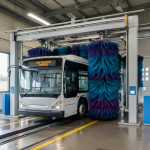Are Public Transportation and School Bus Operators prioritizing cleanliness and hygiene as a part of their operations? In today’s world, where health and safety are paramount, implementing a comprehensive wash policy is more important than ever. This article delves into the significance of ensuring a clean and properly maintained fleet of buses for public transportation and school bus operators.
A comprehensive wash policy not only enhances the aesthetic appeal of the vehicles but also plays a key role in mitigating health risks. Buses are used by a large number of people daily, increasing the likelihood of the spread of viruses and germs. By regularly sanitizing and disinfecting the buses, operators can help create a healthy and safe environment for passengers.
Moreover, a clean and well-maintained fleet reflects positively on the reputation of the operators. It instills confidence in commuters and parents, ensuring that they choose public transportation and school buses with peace of mind.
By implementing a comprehensive wash policy, public transportation and school bus operators not only prioritize the health and well-being of their passengers but also contribute to a cleaner and safer community overall. Join us as we explore the importance of maintaining cleanliness in the transportation industry.
The importance of maintaining cleanliness in public transportation
Cleanliness is an essential aspect of public transportation. With thousands of people relying on buses and trains for their daily commute, it is crucial to ensure that these vehicles are clean and free from dirt, debris, and germs. A dirty and unkempt vehicle not only creates a negative impression but also poses health risks to passengers.
Regular cleaning and maintenance of public transportation vehicles help eliminate allergens, bacteria, and viruses that may be present on surfaces. This is particularly important in preventing the spread of diseases, especially during flu seasons or outbreaks. A comprehensive wash policy ensures that all surfaces, including seats, handrails, and windows, are thoroughly cleaned and disinfected to minimize the risk of contamination.
In addition to health benefits, maintaining cleanliness in public transportation also contributes to a positive passenger experience. A clean and fresh-smelling vehicle creates a pleasant and inviting atmosphere, making the commute more enjoyable for passengers. It also fosters a sense of pride and professionalism among operators, as they can showcase their commitment to providing a safe and comfortable journey for their customers.
Implementing a comprehensive wash policy is not just a matter of aesthetics or hygiene; it is a responsibility towards the well-being of passengers and the community as a whole. Let’s explore the various health and safety considerations in public transportation and school buses.
Health and safety considerations in public transportation and school buses
Public transportation and school buses are unique environments with specific health and safety considerations. These vehicles accommodate a large number of people, often in close proximity, increasing the risk of the spread of diseases and infections. As such, it is crucial for operators to prioritize cleanliness and hygiene to protect the health and safety of passengers, especially vulnerable individuals such as children and the elderly.
One of the primary health concerns in public transportation is the transmission of respiratory infections. Viruses, such as the flu or common cold, can easily spread through close contact or by touching contaminated surfaces. Regular cleaning and disinfection of frequently touched areas, such as handrails, seats, and door handles, can significantly reduce the risk of transmission.
School buses, in particular, require extra attention to hygiene due to the presence of young children. Children are more susceptible to infections and may not have developed proper hygiene practices. As a result, school bus operators must implement rigorous cleaning protocols to ensure the safety of their young passengers.
Apart from respiratory infections, public transportation and school buses also face challenges related to sanitation and waste management. Restrooms on buses, if available, must be cleaned and disinfected regularly to prevent the spread of germs. Waste disposal systems should be properly maintained to avoid odors and contamination.
By addressing these health and safety considerations through a comprehensive wash policy, public transportation and school bus operators can create a clean and safe environment for passengers. Not only does this protect the health of individuals, but it also promotes the overall well-being of the community.
Now that we understand the importance of cleanliness in public transportation, let’s explore the benefits of implementing a comprehensive wash policy.
Benefits of implementing a comprehensive wash policy
Implementing a comprehensive wash policy for public transportation and school bus operators offers a wide range of benefits. From improved passenger satisfaction to reduced health risks, a well-maintained fleet can have a positive impact on both the operators and the community. Let’s delve into the advantages of having a robust wash policy in place.
### 1. Enhanced Passenger Experience
A clean and well-maintained vehicle enhances the overall passenger experience. When commuters step onto a bus or a train that is visually appealing and smells fresh, it creates a positive impression and sets the tone for a pleasant journey. Passengers are more likely to feel comfortable and at ease, leading to increased satisfaction and loyalty.
### 2. Health and Safety
As mentioned earlier, a comprehensive wash policy plays a crucial role in maintaining the health and safety of passengers. Regular cleaning and disinfection of surfaces help prevent the spread of diseases and infections. By prioritizing cleanliness, operators demonstrate their commitment to protecting the well-being of their customers.
### 3. Improved Reputation and Trust
A clean and well-maintained fleet reflects positively on the reputation of public transportation and school bus operators. When commuters and parents see operators taking cleanliness seriously, it instills confidence and trust in their services. This, in turn, leads to increased ridership and a positive perception of the operator within the community.
### 4. Cost Savings
While implementing a comprehensive wash policy requires an initial investment, it can lead to long-term cost savings. Regular maintenance and cleaning help prevent the build-up of dirt, grime, and rust, which can cause damage to the vehicles if left unaddressed. By proactively maintaining the fleet, operators can extend the lifespan of their buses, reducing the need for frequent repairs or replacements.
### 5. Environmental Impact
A comprehensive wash policy can also have a positive impact on the environment. By using eco-friendly cleaning products and implementing water-saving measures, operators can minimize their carbon footprint. This demonstrates a commitment to sustainability and responsible business practices.
By considering these benefits, public transportation and school bus operators can recognize the value of implementing a comprehensive wash policy. However, it is essential to understand the key components that make up an effective wash policy. Let’s explore these components in the next section.
Components of a comprehensive wash policy
A comprehensive wash policy for public transportation and school buses should encompass various components to ensure thorough cleaning and maintenance. The following elements are essential for an effective wash policy:
### 1. Regular Cleaning Schedule
Establishing a regular cleaning schedule is crucial to maintain cleanliness consistently. This includes daily cleaning routines, as well as more extensive cleaning sessions at designated intervals. Operators should consider factors such as vehicle usage, passenger volume, and weather conditions to determine the frequency and intensity of cleaning.
### 2. Thorough Cleaning Procedures
A comprehensive wash policy should outline detailed cleaning procedures to ensure all areas of the vehicle are cleaned properly. This includes both interior and exterior surfaces, such as seats, floors, windows, and the exterior body. Operators should provide clear guidelines on the use of cleaning products, equipment, and techniques to ensure effective cleaning.
### 3. Sanitization and Disinfection Protocols
Given the current health concerns, sanitization and disinfection protocols are paramount. Operators should establish guidelines for the use of appropriate sanitizers and disinfectants to eliminate germs effectively. High-touch surfaces, such as handrails and seat handles, should receive special attention to minimize the risk of transmission.
### 4. Waste Management
Proper waste management is an integral part of a comprehensive wash policy. Operators should establish protocols for waste disposal, including trash collection and restroom waste management. This ensures a clean and odor-free environment for passengers.
### 5. Exterior Washing and Maintenance
Maintaining the exterior appearance of the vehicles is equally important. A comprehensive wash policy should include guidelines for exterior washing, including the use of suitable cleaning agents and techniques. Additionally, operators should implement regular inspections and maintenance to address any issues such as paint damage or rust.
By incorporating these components into their wash policy, operators can ensure a comprehensive approach to cleanliness and maintenance. However, it is essential to train and educate staff members on these policies to achieve consistent implementation. Let’s explore the best practices for washing public transportation vehicles and school buses.
Best practices for washing public transportation vehicles and school buses
To effectively implement a comprehensive wash policy, public transportation and school bus operators should follow best practices for washing their vehicles. These practices help ensure thorough cleaning, proper maintenance, and adherence to hygiene standards. Let’s dive into some of the key best practices:
### 1. Use of Eco-Friendly Cleaning Products
Choosing eco-friendly cleaning products is not only environmentally responsible but also safer for passengers and staff. Operators should select products that are effective in removing dirt and germs while minimizing the use of harsh chemicals. This helps maintain a healthy and sustainable cleaning process.
### 2. Proper Equipment and Techniques
Using the right equipment and techniques is essential for achieving optimal cleaning results. Operators should provide their staff with appropriate cleaning tools, such as microfiber cloths, brushes, and mops, to ensure thorough cleaning. In addition, training on the correct use of equipment and techniques should be provided to maximize efficiency.
### 3. Focus on High-Touch Surfaces
High-touch surfaces, such as handrails, seat handles, and buttons, should be given special attention during the cleaning process. These areas are more likely to harbor germs and require frequent sanitization and disinfection. Using disinfectant wipes or sprays can help effectively eliminate pathogens from these surfaces.
### 4. Regular Inspection and Maintenance
In addition to cleaning, regular inspection and maintenance are crucial for ensuring the longevity of public transportation vehicles and school buses. Operators should establish protocols for routine inspections to identify and address any issues promptly. This includes checking for signs of damage, wear and tear, or malfunctioning equipment.
### 5. Staff Training and Education
Proper training and education are essential for effective implementation of a comprehensive wash policy. Operators should invest in training programs to educate their staff on cleanliness practices, equipment usage, and safety protocols. This ensures that cleaning procedures are followed consistently and to the highest standards.
By following these best practices, public transportation and school bus operators can maintain a clean and safe environment for passengers. However, the success of a wash policy also depends on compliance and enforcement. Let’s explore these aspects in the next section.
Training and education for wash policy implementation
Implementing a comprehensive wash policy is not enough; it is equally important to ensure compliance and enforcement. Operators should establish protocols to monitor and enforce adherence to the wash policy guidelines. This includes the following measures:
### 1. Regular Audits and Inspections
Conducting regular audits and inspections helps identify any gaps or non-compliance with the wash policy. Operators should establish an audit schedule to review the cleaning procedures, maintenance records, and overall cleanliness of the fleet. This ensures that standards are consistently met and deviations are addressed promptly.
### 2. Quality Control Measures
Implementing quality control measures is crucial to maintain consistent standards of cleanliness. This can include random checks, sample testing, or customer feedback surveys. By regularly evaluating the quality of the cleaning process, operators can address any deficiencies and reinforce the importance of compliance.
### 3. Staff Accountability
Operators should hold their staff accountable for following the wash policy guidelines. This can be achieved through regular training and reminders, performance evaluations, and recognition for adherence to standards. By emphasizing the importance of compliance, operators can foster a culture of cleanliness and responsibility among their staff.
### 4. Communication and Transparency
Clear communication is essential for ensuring compliance with the wash policy. Operators should communicate the importance of cleanliness to their staff and passengers through various channels, such as training sessions, signage, and announcements. Transparency regarding the cleaning procedures and frequency also helps build trust and confidence among passengers.
Compliance and enforcement of wash policies
By implementing effective compliance and enforcement measures, operators can ensure that their wash policy is followed consistently and that cleanliness remains a priority. To further emphasize the significance of implementing a comprehensive wash policy, let’s explore some real-life case studies and success stories.
Case studies and success stories of organizations with effective wash policies
Several organizations have successfully implemented comprehensive wash policies, setting a benchmark for cleanliness and hygiene in public transportation and school bus operations. Let’s take a look at some notable case studies and success stories:
### 1. Metro Transit, Minneapolis
Metro Transit, the primary public transportation provider in the Minneapolis-St. Paul area, has implemented a comprehensive wash policy to ensure cleanliness and hygiene on their buses and trains. They have established a rigorous cleaning schedule, with a focus on high-touch surfaces and regular disinfection. Metro Transit also provides ongoing training to their staff on cleaning procedures and has implemented compliance measures to ensure adherence to the wash policy.
### 2. Montgomery County Public Schools, Maryland
Montgomery County Public Schools in Maryland has taken proactive measures to maintain cleanliness and hygiene on their school buses. They have implemented a robust wash policy that includes daily cleaning routines, sanitization protocols, and regular inspections. In addition, they have partnered with local health authorities to receive guidance on best practices for preventing the spread of diseases. These efforts have resulted in a clean and safe environment for students, instilling confidence among parents and the community.
### 3. Transport for London, United Kingdom
Transport for London (TfL) has implemented a comprehensive wash policy across its extensive network of buses, trains, and underground stations. TfL has established strict cleaning schedules, with frequent disinfection of high-touch surfaces. They have also implemented innovative technologies, such as antimicrobial coatings on surfaces, to enhance cleanliness. TfL’s commitment to maintaining a clean and safe environment has been recognized internationally, setting an example for other transportation authorities.
These case studies highlight the positive impact of implementing a comprehensive wash policy in public transportation and school bus operations. By prioritizing cleanliness and hygiene, these organizations have not only enhanced the passenger experience but also contributed to the overall well-being of their communities.
Conclusion: The future of wash policies in public transportation and school bus operations
As we conclude our exploration of the importance of implementing a comprehensive wash policy for public transportation and school bus operators, it is evident that cleanliness and hygiene play a vital role in ensuring the health and safety of passengers.
By regularly cleaning, sanitizing, and maintaining their fleets, operators can mitigate health risks, enhance the passenger experience, and build trust within their communities. The benefits of a comprehensive wash policy go beyond aesthetics;
A comprehensive wash policy not only enhances the aesthetic appeal of the vehicles but also plays a key role in mitigating health risks. Buses are used by a large number of people daily, increasing the likelihood of the spread of viruses and germs. By regularly sanitizing and disinfecting the buses, operators can help create a healthy and safe environment for passengers.
One of the main benefits of a comprehensive wash policy is the reduction of pathogens on buses. Studies have shown that buses can harbor various pathogens, including influenza viruses and bacteria such as E. coli. These pathogens can survive on surfaces for extended periods, posing a risk to both passengers and drivers. Regularly washing and disinfecting the buses can significantly reduce the presence of these pathogens, minimizing the chances of infections spreading among passengers.
In addition to reducing pathogens, a comprehensive wash policy also helps control allergens and pollutants. Buses can accumulate dust, pollen, and other allergens, which can trigger allergies and respiratory problems in susceptible individuals. By thoroughly cleaning the interiors and exteriors of the buses, operators can create a healthier environment for passengers, especially those with respiratory conditions. Furthermore, washing the buses regularly can also remove pollutants such as exhaust residue and road grime, improving the air quality inside the vehicles.
By implementing a comprehensive wash policy, public transportation and school bus operators not only prioritize the health and well-being of their passengers but also contribute to a cleaner and safer community overall.




